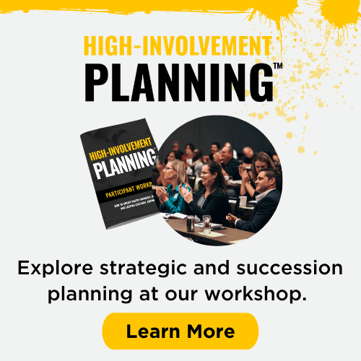
Most companies spend countless hours working on strategy, sales and growth plans, financial plans, and 5-year forecasts, also known as HIP (High-Involvement Planning™). They have numerous spreadsheets, presentations, and market data to support their plan. They bring in macro and micro-financial gurus to validate their information. The board approves the plan, and everything is ready to go.
Wait a minute. The company forgot to answer the most important question. Who will be responsible/accountable for making sure this gets accomplished? Do we have enough capable and available leaders to grow the top and bottom line 10%? Who is going to open and manage the new locations or the acquisition? Who is going to lead the new product launch? Good question/s.
You can have the most excellent plan in the world. You can have the fanciest slide show with embedded videos and other relevant analytics to support the strategy. But none of that will be executed without the right leadership.
In a different scenario, a business owner is planning to sell their company. They want to protect the legacy and reward those employees who have contributed to its success. So, the owner plans to sell the business to the employees and form an ESOP. However, there is an unanswered question.
 That question is, who will lead the company during and/or after this ownership transition? These two scenarios can be answered by creating and implementing a leadership succession development plan(LSDP). It's a process that is part of your annual planning. It goes hand-in-hand with your strategy, sales and growth plans, financial plans, and 5-year forecasts. Its primary focus is answering the question, "Who is going to lead these initiatives?"
That question is, who will lead the company during and/or after this ownership transition? These two scenarios can be answered by creating and implementing a leadership succession development plan(LSDP). It's a process that is part of your annual planning. It goes hand-in-hand with your strategy, sales and growth plans, financial plans, and 5-year forecasts. Its primary focus is answering the question, "Who is going to lead these initiatives?"
The LSDP can be broken into 3 steps. They are, evaluate your current leadership, identify the gaps, and formulate a plan to support the company's strategy.
Next, we will look at each one of these steps in detail.
Step #1- Evaluate your current leadership
a) Develop a list of competencies- Create a list of professional and transversal competencies for each leadership position. Professional competencies are those skills explicitly related to their position. For example, a Sales Manager's professional competencies may include product knowledge, negotiating skills, or presentation to customers. Transversal competencies are skills that all leaders should have. These skills include communication, servant leadership, problem-solving, or working with others.
*Make sure your company's core values are listed as transversal competencies.
*Be sure to include a definition of each competency. Definitions will provide clarity for all current and potential leaders on what success looks like for each competency.
b) Evaluate all current leaders based on those competencies- Each competency that you list should be separated into 5 columns, with each listed 1-5. With 1 being "needs improvement" and 5 being "excels." Each leader in the company should evaluate themselves first and then be evaluated by the person they report to. This will ensure there is alignment.
It is very important to be candid and honest during these evaluations. Leaders are not helping the company or the leaders they evaluate by not being transparent. One method of helping leaders evaluate others is to give examples. For example, if you listed someone as a 1 or a 5, you need to provide a specific example of why.
Step #2- Identify the gaps in current leadership
a) Evaluate readiness for the role- Once you have evaluated all the leaders, you must determine if they are a fit within their current position. You can use your company's organizational chart to do this. You would highlight them in red, yellow, or green. If it is red, they are not a fit in their current position. If they are yellow, they have some gaps in some competencies. If they are green, they are a good fit and are performing well. Putting this on an org chart will provide a good visual of how effective your leaders are in their current roles.
b) Evaluate readiness for other leadership roles- For those in their current positions who are performing well (green), evaluate what other leadership roles and/or one level-up role they are ready for. Remember, you must also assess them on that specific role's professional competencies. The evaluation criteria you would use are; ready now, ready in less than a year, ready in less than 2 years, and ready in 3-5 years. This is extremely helpful for future planning and formulating a plan to get them ready by that time.
c) Identify the gaps- For those that have gaps in some competencies, each leader and the leader they are evaluating must understand in detail what those gaps are.
Step #3- Formulate a plan
a) Leadership Development Plan(LDP)- This is for current leaders. Give every leader with gaps in competencies and any leaders who are not currently ready to move up one level or into another leadership position an LDP. An LDP is a written form that identifies the gaps and gives them a list of items to complete. For example, if business acumen needs improvement, a professional development class in financial analysis may be assigned.
*Please note that some leaders may be performing very well in their current leadership position and have no desire to move to a different position. It's not necessary that they have an LDP.
b) Deal with those in red - Develop and execute a plan for leaders shaded in red on your readiness org chart. They are hurting your company more and more every day. It may be that they are just not a fit for the role. They may be very happy and productive working in a different position in the company.
c) Decide what positions need to be filled externally- If you have no one internally to fill a specific position, you will need to hire someone. Be sure to estimate the time it will take to get this person ready.
d) Review, Update, Execute, Review, Update, Execute- Enough said. Make it a habit to include this as part of your monthly financial review.
Conclusion
Hopefully, this has given you some insight into how important LSDP is for your company. Like any other planning, this process needs to be done every year, and the progress needs to be reviewed and updated monthly. You can't successfully execute High-Involvement Planning without the most important asset: Your people. Your people need great leaders.
Looking to stay ahead of your business? Learn how to build a succession plan that will ensure your company has all of the right people and talent identified to be able to grow your company.
By consistently developing and training your people, you can make sure growth is never an unorganized burden, but a smooth transition! Join us for our next workshop focusing on Strategic and Succession Planning.
.png)


.png?width=790&name=HIP%20Workshop%20CTA%20(1).png)





.png)




-5.png)
.png)
